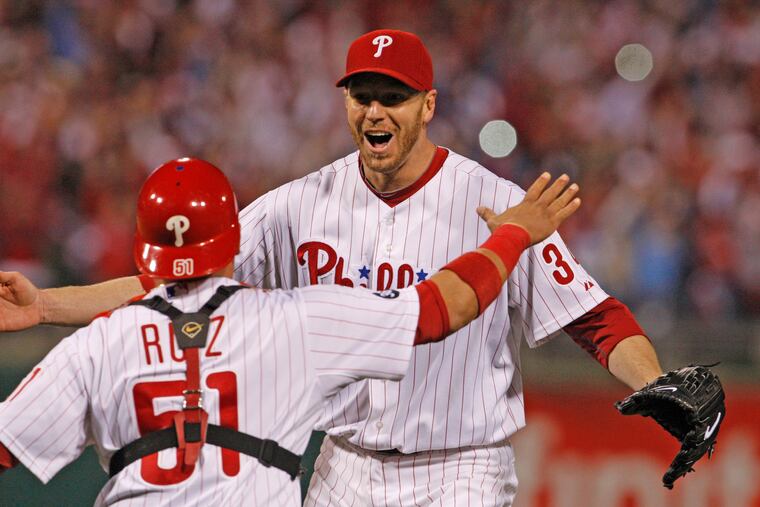Roy Halladay would have wanted his Hall of Fame plaque to have a Phillies hat | Bob Ford
Halladay's best moments were in the postseason with the Phillies.

The Phillies didn’t make Roy Halladay. He had already won a Cy Young Award and established himself as a great major-league starter when he joined the team for spring training in 2010.
They didn’t make him as a pitcher, or as a workaholic grinder, or as a man of determination regardless of the obstacle. Chase Utley tells the famous story of arriving at 5:45 a.m. at the Carpenter Complex on the first day of that 2010 spring training and encountering Halladay eating his breakfast. He was soaking wet.
“Was it raining when you came in?” Utley asked, puzzled.
“No, I just finished my workout,” Halladay said.
That’s how he came in the door, and the Phillies had nothing to do with that. The thing is that the Toronto Blue Jays, the team that drafted him and for which he played 11 major-league seasons, didn’t make Roy Halladay, either. He had an affection and an appreciation for the organization, and his early struggles there helped forge Halladay’s iron will, but external forces didn’t guide him.
What the Phillies gave Halladay, however, was the thing that mattered the most to him. They gave him the postseason. They gave him the crucible where his beliefs about himself would be put to the greatest test.
“For me, just having the opportunity meant every bit as much as winning it or not winning it,” Halladay told the New York Times shortly before his death. “The rest, as they say, it’s in the cards. But as far as what you can control, just having those opportunities was all I ever wanted.”
Halladay was never more engaged as a player, never more fully alive in a moment, than during the final act of his first playoff start, as he stared in at Brandon Phillips of Cincinnati, already ahead 0-2 in the count, one pitch away from recording just the second no-hitter in postseason history. He bent forward for the sign, the bill of the cap shading his eyes, and the white “P” on a red background stating his loyalties.
The hat is in the Hall of Fame, of course, and after Tuesday’s election announcement, so is the pitcher himself. Halladay wouldn’t have gotten there without the 148 games he won for the Blue Jays, but if he were with us today and given the chance to relive one of his 395 career starts, the choice would be easy. Halladay would pick one of the five he started for the Phillies in the postseason. It wouldn’t even need to be one of the three wins. The winning and losing were up to the cards that evening. Just put him on the mound in that situation, with that chance to try.
Roy Halladay was a gracious man. He wouldn’t want to insult the Toronto Blue Jays. But, in my heart, having been around him, I believe he would want his Hall of Fame plaque to portray that grim, unflinching stare that batters knew so well. And, above the brim that shaded his eyes, I think he would want a “P.”
Maybe it doesn’t matter now. There’s little chance that will happen, anyway. The hat on his plaque, according to his wife, Brandy, will be blank, with neither the "P" nor the bird-head-in-profile of the Blue Jays logo. The tragedy isn’t the affiliation or lack of it that will be on the plaque, but that Halladay won’t be in Cooperstown this July to hold it aloft.
The speculation that he would have chosen the symbol of his enshrinement to be a Phillies hat is nothing more than that, but it stays with me. The Blue Jays traded Halladay for prospects Travis d’Arnaud, Kyle Drabek, and Michael Taylor. To sweeten the deal, as if getting Roy Halladay wasn’t sweet enough, Toronto threw in cash. The Blue Jays were in a rebuilding and cost-cutting mode at the time, and Halladay certainly understood the reasons for the trade, but the organization he pitched for from age 18 to 32 had essentially let him down. He hadn’t pitched a single postseason inning.
The ultimate prize eluded him in Philadelphia. He was just a couple of years late. The chance to compete for it didn’t elude him, however. Halladay won his second Cy Young Award, and became the only pitcher to throw both a perfect game and a no-hitter in the same season. In 2010, he led the major leagues in wins, innings, complete games, and shutouts and the National League in batters faced, walks per nine innings, and strikeout-to-walk ratio.
Those are just numbers. They aren’t the man. It was Halladay who made the numbers, not the other way around. He made them before the sun came up at the Carpenter Complex, and he made them by studying hitters like a scientist, and by focusing so hard on each pitch that his face became a mask of steely concentration.
I know what I see above that face, above those narrowed eyes shielded by the brim. I know what Roy Halladay saw up there, too.